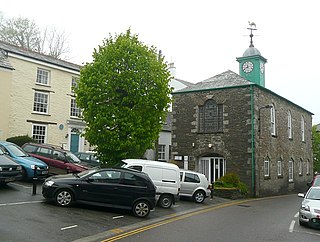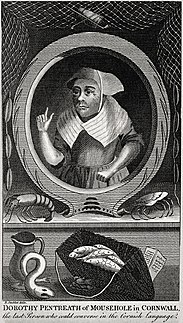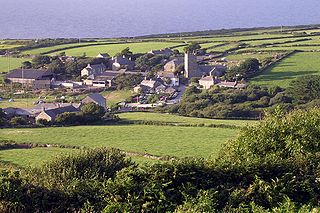
Cornish is a Southwestern Brittonic language of the Celtic language family. It is a revived language, having become extinct as a living community language in Cornwall at the end of the 18th century. However, knowledge of Cornish, including speaking ability to a certain extent, continued to be passed on within families and by individuals, and a revival began in the early 20th century. The language has a growing number of second language speakers, and a very small number of families now raise children to speak revived Cornish as a first language. Cornish is currently recognised under the European Charter for Regional or Minority Languages, and the language is often described as an important part of Cornish identity, culture and heritage.

Camelford is a town and civil parish in north Cornwall, England, United Kingdom, situated in the River Camel valley northwest of Bodmin Moor. The town is approximately ten miles (16 km) north of Bodmin and is governed by Camelford Town Council. Lanteglos-by-Camelford is the ecclesiastical parish in which the town is situated. The ward population at the 2011 Census was 4,001. The town population at the same census was 865.

Dorothy Pentreath, known as Dolly, was the last known native speaker of the Cornish language. She is also the best-known of the last fluent speakers of Cornish.

Treen is a small village in the parish of St Levan, in the far west of Cornwall, England, United Kingdom. It is about 3 miles (4.8 km) inland from Land's End on a short unclassified spur road from the B3315. Treen overlooks the Penberth Valley and sits about 1 kilometre (0.62 mi) inland from Treryn Dinas, an Iron Age promontory fort, or cliff castle, with five lines of fortification. On the headland is the Logan Rock and to the west is Pedn Vounder tidal beach, which is popular with naturists. Treen Cliff is to either side of Treryn Dinas. The village has a popular pub, The Logan Rock Inn, a village shop, cafe and campsite with views to both Logan Rock and nearby Porthcurno.

The Cornish people or Cornish are a Celtic ethnic group and nation native to, or associated with Cornwall and a recognised national minority in the United Kingdom, which can trace its roots to the ancient Britons who inhabited southern and central Great Britain before the Roman conquest. Many in Cornwall today continue to assert a distinct identity separate from or in addition to English or British identities. Cornish identity has been adopted by migrants into Cornwall, as well as by emigrant and descendant communities from Cornwall, the latter sometimes referred to as the Cornish diaspora. Although not included as an explicit option in the UK census, the numbers of those claiming Cornish ethnic and national identity are officially recognised and recorded.

Zennor is a village and civil parish in Cornwall, England, United Kingdom. The parish includes the villages of Zennor, Boswednack and Porthmeor and the hamlet of Treen. Zennor lies on the north coast, about 6 miles (10 km) north of Penzance, along the B3306 road which connects St Ives to the A30 road. Alphabetically, the parish is the last in Britain. Its name comes from the Cornish name for the local saint, Saint Senara.

St Levan is a civil parish in Cornwall, England, United Kingdom. The parish is rural with a number of hamlets of varying size with Porthcurno probably being the best known. Hewn out of the cliff at Minack Point and overlooking the sea to the Logan Rock is the open-air Minack Theatre, the inspiration of Rowena Cade in the early 1930s.

Ludgvan is a civil parish and village in Cornwall, England, UK, 2+1⁄2 miles (4.0 km) northeast of Penzance. Ludgvan village is split between Churchtown, on the hill, and Lower Quarter to the east, adjoining Crowlas. For the purposes of local government, Ludgvan elects a parish council every four years; the town elects a member to Cornwall Council under the Ludgvan division.

Delabole is a large village and civil parish in north Cornwall, England, UK. It is situated approximately two miles (3 km) west of Camelford.

Gurnard's Head is a prominent headland on the north coast of the Penwith peninsula in Cornwall, England, UK. The name is supposed to reflect that the rocky peninsula resembles the head of the gurnard fish.

St Endellion is a civil parish and hamlet in north Cornwall, England, United Kingdom. The hamlet and parish church are situated four miles (6.5 km) north of Wadebridge.

Bosporthennis is a hamlet south of Treen in the civil parish of Zennor on the Penwith peninsula in west Cornwall, England, United Kingdom.
The "Cranken Rhyme" is a Cornish-language song known by farmer John Davey or Davy (1812–1891), who was one of the last people with some knowledge of the tongue. It was recorded by J. Hobson Matthews in his History of St. Ives, Lelant, Towednack, and Zennor, and is probably the latest known traditional Cornish verse.

John Davey or Davy (1812–1891) was a Cornish farmer who was one of the last people with some traditional knowledge of the Cornish language. According to Henry Jenner, the level of his ability in the language is unclear, but was probably restricted to a few words and phrases. A song attributed to Davey's memory, the "Cranken Rhyme", is not known from any earlier source and is notable as possibly one of the last survivals of Cornish literary tradition.

Withielgoose or Withel-goose is a hamlet in Cornwall, England, UK. Withielgoose, from the Cornish gwyth (trees), yel and coes (wood) suggests the clearance of woodland to create agricultural land. The hamlet is accessed via Withielgoose Lane and contains Withielgoose Manor. Withielgoose belongs historically to the parish of Withiel along with Retire and Tregawne; the parish had a total population of about 300 in 1824. It lies about five miles west of Bodmin and six miles east north east of St Columb Major.

Saint Senara is a legendary Cornish saint with links to the village of Zennor on the north coast of Cornwall , UK. The Church of Saint Senara, Zennor is dedicated to her; the village, nearby headland Zennor Head, and the neolithic tomb Zennor Quoit received her name indirectly.

The B3306, also known as the West Cornwall Coast Road, is a major road of southwestern Cornwall. It connects St Ives in the east to St Just in the west, and eventually joins the A30 road to the northeast of Sennen in the southwest of the Penwith peninsula. This thirteen-mile road is often voted one of the greatest driving roads in the United Kingdom for its scenery, with most of the road having views both across the Celtic Sea to the north, and the Cornish moorland to the south. It hugs the coastline for a great proportion of its length.
Identifying the last native speaker of the Cornish language was a subject of academic interest in the 18th and 19th centuries, and continues to be a subject of interest today. The traditional view that Dolly Pentreath (1692-1777) was the last native speaker of the language has been challenged by records of other candidates for the last native speaker, and additionally there are records of others who had knowledge of the language at a later date, while not being native speakers.

Ludgvan is an electoral division of Cornwall in the United Kingdom and returns one member to sit on Cornwall Council. The current Councillor is Simon Elliot, a Conservative.

















